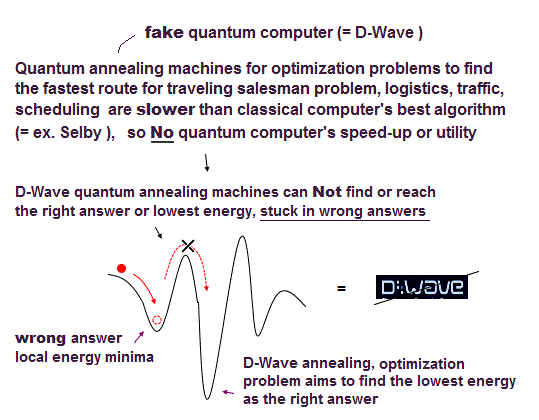
Home page
Quantum computer is dead.
Fake quantum computer
advantage
(Fig.1) Quantum annealing or D-Wave for optimization problems is useless, showing No quantum advantage.

Quantum annealing machines or quantum adiabatic computers are said to solve optimization problems finding the lowest energy states ( this p.2-4 ) encoding the fastest route, efficient scheduling, logistics, traffic flow under given conditions (= input some parameters ), which is a complete fraud and hype ( this-9/4/2025, this-abstract-last ).
This-first (11/22/2025) says -- Useless D-Wave
"D-Wave Quantum's quantum computer is still years away from commercial viability."
Actually, fraudulent D-Wave just increased loss with No profit from its impractical (= Not faster ) quantum annealing (= or deceptive hybrid that is just classical computer, this-p.1,p.3 ), just spreading fake news.
This Quick overview (11/6/2025) says
"D-Wave's ongoing cash burn and lack of profitability" ← D-Wave just increased its net loss (= revenue minus total expenses, so D-Wave suffers deficit, this-3rd-paragraph ) with No profit (= No real quantum computer advantage ).
This or this-3rd-paragraph (11/8/2025) says
"Yet, the company's net loss of $140 million-- casts a shadow over its profitability,.. This discrepancy between revenue growth and profitability... raises questions about the sustainability of D-Wave's business model. "
Quantum computers are useless, fraud with No hope of practical use.
So all quantum computer's public companies such as D-Wave and IonQ always suffering net loss have to get money by issuing new shares whose price can be easily raised by overhyped fake news.
The 11th-paragraph of this says
"IonQ is performing equity issuances to raise funds."
↑ The mainstream science such as useless quantum computers and AI has an enormous power to raise money just by spreading overhyped fake news, supported by almost all the media and academia.
This quantum annealing or D-Wave, where the system or qubits gradually settle down to the lowest energy equilibrium state (= the lowest-energy state means the fastest logistics or scheduling based on the input parameters ) without computation, almost always reaches the erroneous local energy minima (= always giving wrong answers ), which is impractical, No quantum advantage.
So the alleged quantum computer's speed-up or advantage ( in finding the faster more efficient scheduling, logistics or transportation routes ) you often see in the overhyped media is fake, based on comparison with deliberately-chosen bad classical methods (= good classical computer's methods easily outperform the quantum computers or D-Wave ).
D-Wave falsely claims that quantum tunneling may help finding global energy minimum (= solution ), but the probability of tunneling is extremely tiny, which means they almost always get wrong answers and have to repeat measurements, until luckily finding the right answers, which is impractical, too time-consuming.
This-p.2-4th-paragraph & p.7-2nd-paragraph say (2025) -- Useless D-Wave
"the current implementations of quantum annealing in
optimisation are limited in size and Not yet upscaled to real-world situations ( this-5th-last-paragraph )"
"our conclusion that D-Wave fails to provide optimal solutions "
↑ Just repeating the operations and measurement taking too much time is the only way for quantum annealing to find the global energy minimum or solution, so D-Wave has to rely on classical computers disguised as hybrid quantum computers.
These quantum annealing machines represented by D-Wave for allegedly making traffic and logistic more efficient are Not real quantum computers, so No quantum advantage nor speed-up in this fake quantum annealing computer ( this p.2-right-1st-paragraph, this p.4,p.16, ), even in the stunt factoring ( this-No quantum speedup-7/2/2025 ).
This-p.1-2nd-paragraph (4/2025) say -- D-Wave showed No advantage
"D-Wave customers we interviewed in key verticals like logistics, manufacturing, and
pharmaceuticals reported seeing zero benefit from the technology"
This-p.5-right-1st-paragraph says -- classical is superior
"We compare D-Wave Quantum Annealer' s results to
Gurobi 10.0 on classical
hardware. Gurobi (= classical computer methods ) outperforms D-Wave"
This-p.10-2nd-last-paragraph (2024) says -- useless quantum annealing
"From
this, we can conclude that quantum annealers are too small and too prone to errors, and hence, for more accurate
solutions to larger problems, we opt for hybrid quantum-classical solvers"
All the alleged quantum computers solving optimization problems for finding faster traffic, logistics, scheduling are fake quantum annealing or deceptive hybrid quantum-classical computers ( this-7~8th-paragraphs, this-3rd-paragraph ) which are just classical computers ( this-p.3 ), which are overhyped, slower than ordinary classical computers ( this-p.1-abstract-last, this-lower-challenges ).
This-8th-paragraph (4/2/2025) says -- No quantum computers
"many challenges remain. Quantum computers are still in their early stages (= impractical ), and their large-scale deployment is years,"
This-4th-last-paragraph (5/11/2025) says -- useful classical computers
"this is still a developing field. The hardware has a long way to go (= quantum computer hardware is still impractical ). Many quantum systems.. are prone to errors. But... We're entering a phase where quantum and classical systems can work together (= which means they must heavily rely on classical computers )"
This-middle-short-term outlook (3/4/2025) says -- quantum computer's errors.
"In the short term, over the next one to five years, quantum computing will remain in what researchers call the Noisy Intermediate-Scale Quantum (NISQ) era... still limited by noise and error rates.... hybrid quantum-classical solutions—where quantum processors work alongside classical computers"
(Fig.N) Quantum computer advantage or speed-up is just fake news.
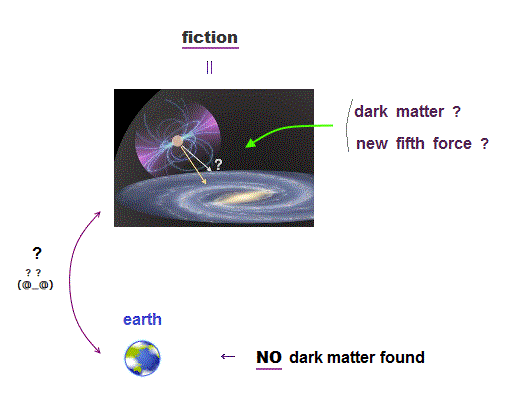
Insider brief of this hyped news (4/2/2025) says -- quantum hype
"Ford Otosan has implemented a production-grade hybrid-quantum (= just classical computer ) application using D-Wave's annealing quantum computing to optimize vehicle sequencing.... reduced vehicle scheduling time from 30 minutes to under five, improving manufacturing efficiency (= compared to bad or Not-best classical methods, so No real quantum computer's advantage )"
The 4th-last and 2nd-last paragraphs of this hyped news (2/18/2025) say
"The hybrid-quantum application (= just classical computer ), demonstrated to outperform classical approaches (= deliberately-chosen bad classical approach )"
"we believe (= just believe, still unrealized ) that quantum computing can provide the speed"
The 3rd paragraph of this hyped news (7/29/2025) says -- fishy advantage
"by deploying quantum computing technology (= Not meaning "quantum computers" )... a combinatorial optimization quantum system...achieving a 10% increase in downlink speeds (= this research with No mention of detailed quantum computer machines means just classical computer's simulation with No quantum advantage )"
The point is D-Wave's hybrid quantum computers allegedly showing (fake) quantum advantage are just ordinary classical computers.
This-p.3-3rd-paragraph says -- fake hybrid = classical
"Based on comments from former D-Wave insiders, the hybrid approach is driven
almost entirely by advanced classical algorithms"
Quantum annealing machines of D-Wave are too error-prone, useless, showing No quantum advantage, contrary to overhyped fake news.
So D-Wave started to disguise ordinary classical computers as "hybrid quantum computers" to claim fake advantage over deliberately-chosen bad classical methods.
↑ Of course, their deceptive hybrid computers, which are just classical computers, cannot outperform ( good ) classical computers' methods.
This-3rd-paragraph (4/2025) says -- D-Wave's lie
"customer feedback from logistics, manufacturing, and pharmaceuticals showing zero benefits, alongside a former engineer's admission that D-Wave's systems lack evidence of faster optimization"
This-p.1-abstract-last says (2025) -- Hybrid is useless
" While D-Wave (= hybrid ) can solve such problems, its performance has Not yet
matched that of its classical counterparts" ← No hybrid advantage
This-2nd~3rd-paragraphs (9/4/2025) say -- Classical beats D-Wave
"VeloxQ1 runs on standard (= classical ) computers (!), without the need for expensive and unstable quantum hardware"
"VeloxQ1 (= classical computer ) was evaluated against quantum hardware platforms, including D-Wave Advantage and Advantage2,.. It was also tested against hybrid quantum-classical systems,.. In all scenarios,.. VeloxQ1 consistently outperformed its competitors in both accuracy and computational speed."
↑ No advantage in D-Wave quantum annealers nor hybrid quantum computers.
This-p.8-right-last-paragraph (7/11/2025) says -- useless quantum computer
"quantum
technologies are Not yet mature enough to compete with
highly optimized classical technologies for industry-relevant
use cases such as the vehicle routing problem"
This latest paper (9/11/2025) ↓
p.2-1st-paragraph says -- No quantum advantage
"D-Wave hybrid quantum annealing solvers (QA, HQA), and the
classical.. solvers.. CP-SAT... "
"(classical) CP-SAT displayed the best performance for standard and large protein datasets.. For the extra-large protein dataset (11000 to 14000 amino acids), the D-Wave Nonlinear HQA solver performed comparably to CP-SAT" ← D-Wave hybrid (= HQA ) cannot outperform classical CP-SAT methods.
p.42-1st-paragraph says -- D-Wave hybrid is useless
" The Leap CQM HQA (= D-Wave hybrid ) is unable to
obtain optimal solutions for certain problems although finding near-optimal
solutions; the unconstrained D-Wave solvers are unable to identify optimal
solutions in a reasonable time"
↑ D-Wave's hybrid computers could Not get right (= optimal) solutions.
This-p.9-left-2nd-paragraph says
"On the other hand, the NL-Hybrid (= new D-Wave's hybrid ) has shown inferior
performance compared to other hybrid alternatives"
↑ Even D-Wave's latest hybrid methods (= nonlinear or NL hybrid ) is inferior.
(Fig.S) Quantum supremacy of quantum annealing or D-Wave was fake, far slower, more error-prone than good classical computer's methods.
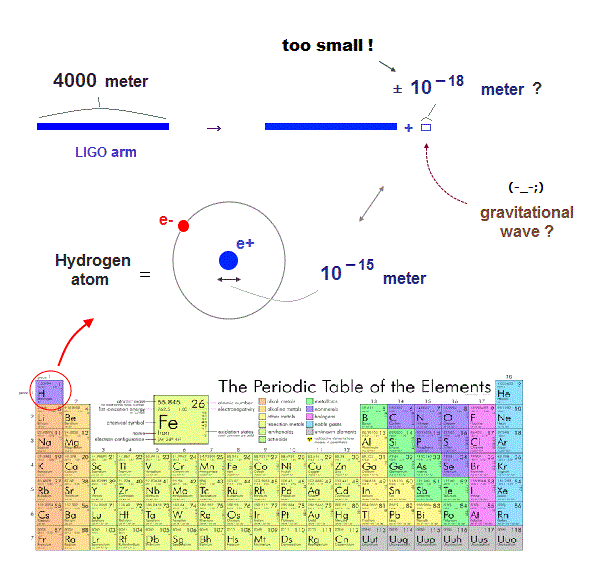
Many overhyped claims that these annealing machines might be faster than ordinary classical computers are based on unfair comparison with bad classical methods (= good classical computer's methods easily outperformed quantum annealing or D-Wave, No quantum advantage ).
The 1st, 8th paragraphs of this ( or this, 3/12/2025 ) say -- No supremacy
"D-Wave's claim that its quantum computers can solve problems that would take hundreds of years on classical machines have been undermined by two separate research groups showing that even an ordinary (= classical ) laptop can perform similar calculations"
"his (classical computer's) tensor approach could easily scale further"
The 11th, 14th paragraphs of this ( or this 3/12/2025 ) say -- slower quantum
"D-Wave’s quantum supremacy claim is also being disputed by physicists particularly those who say classical computers still have their place."
"Look, this one problem at this one time didn't beat classical computers. Try again ( this-last-paragraph )"
↑ This recent D-Wave quantum annealing supremacy claim was also overhyped, fake, as shown in D-Wave's recent bad business loss (= No practical use, though one year has already been passed since this fake supremacy paper was published in arxiv ).
This (or this )-1st, 3rd-last paragraphs (3/12/2025) say -- Classical better
"There's No clear quantum advantage yet in tests of real-world problems"
"our classical approach demonstrably outperforms other reported methods... we are also able to reach errors noticeably lower than the quantum annealing approach employed by the D-Wave Advantage2 system."
This-p.1-right-last-paragraph ~ p.2 (3/10/2025) says -- Classical beats quantum
"In the case
of cylindrical and diamond lattices our ( classical computer's ) simulations reach
accuracies well beyond those of the ( error-prone ) quantum annealer for large system sizes"
↑ Quantum annealing machines or D-Wave are too useless and error-prone, so D-Wave has to rely on ordinary classical computers as (deceptive) hybrid machines that also cannot match the current good classical computers' methods.
Actually, even this or
this latest (fake supremacy) D-Wave paper's p.1-abstract-last just vaguely says
"Thus quantum annealers can answer questions of practical importance that may (= this uncertain phrase means D-Wave is still useless ) remain out of reach for classical computation (← D-Wave changed the expression from this paper's arxiv's abstract-last that didn't use 'may' )."
This-middle-The Controversy; skepticism says -- D-Wave is useless
"even D-Wave admits that solving practical business problems (e.g. in logistics, finance, etc.) on an annealer remains work for the future"
"These limitations lead some researchers to argue that quantum annealers face scaling challenges for truly complex, real-world instances"
This-9th and last paragraphs (3/13/2025) say -- No quantum advantage
"additional research is necessary to confirm whether practical application cases can be resolved in various fields"
"doubts remain as to whether quantum computers can solve problems that classical computers cannot" ← No quantum computer advantage
This-lower-Limitations and future work (for this fake quantum supremacy's first application, 3/22/2025 ) says
"The system is still a prototype, and hurdles remain before a quantum blockchain could be deployed commercially." ← Even D-Wave admits there is still No practical use of this (dubious) quantum supremacy.
This-5th-last ~ 4th-last paragraphs (3/31/2025) say -- Useless D-Wave
"there are No obvious commercial applications (of D-Wave),... there are large number of powerful classical optimization algorithms that can solve these problems directly,"
"notes that media coverage suggesting the results could have practical applications is misleading.... for commercially relevant problems I think this is still far away."
↑ Quantum annealing or D-Wave is still useless (forever despite very long time fruitless researches and hypes ) with No evidence of quantum supremacy nor practical use.
The 1st and 2nd-last paragraphs of this (or this, 3/12/2025 ) say
"D-Wave’s fresh claim that it has achieved “quantum advantage” has sparked criticism of the company—and of the scientific process itself"
"Claims of beating 'all classical methods' are very hard to justify scientifically"
↑ Actually, all these (dubious, fake) quantum supremacy claims of quantum annealing or D-Wave is due to unfair comparisons with deliberately-chosen bad classical computer's methods.
This-p.44-X. monte carlo dynamics (or this-p.47-X ) in this latest Science on (fake) D-Wave supremacy in 2025 mentions D-Wave compared the quantum annealing with (only bad) classical computer methods such as simulated quantum annealing (= SQA ) and Monte Carlo (= MC ), which classical computer methods were allegedly faster than classical tensor-network.
But actually there are various better, faster classical computer's methods such as Selby, Gurobi, even good classical tensor network ) that could outperform the quantum annealing or D-Wave ( this-p.9~p.12, this-15~21th-paragraphs, this-p.6-left-C, this-p.1-abstract-last-2025 ).
The fact that D-Wave's (fake) quantum computer or quantum annealing (= QA ) is more useless, error-prone, slower than classical computers is why D-Wave applied only (deceptive) hybrid computers called CQM (= just classical computers ) to practical purpose, which also cannot match today's good classical computer's methods ( this-p.28-1st-paragraph, this-p.10-2nd-last-paragraph, p.12-conclusion ).
(Fig.C) D-Wave gave up using their error-prone useless quantum ( annealing ) computers, and instead, started to use classical computers as 'hybrid'.
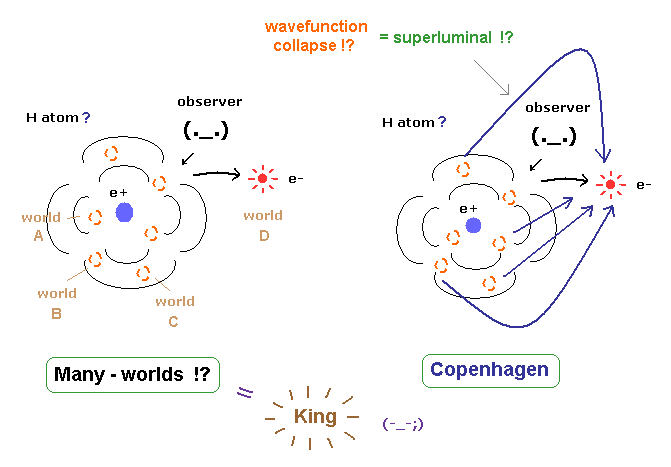
The recent D-Wave claim ( after the useless Willow thing ) that their ( fake ) quantum computers (= annealers ) might benefit business operation is completely untrue.
D-Wave quantum annealing machines are useless, too error-prone to be practical (= often giving wrong local energy minima ), so No quantum advantage ( this p.1-right-last-paragraph ), deadend ( this-2nd-paragraph ).
↑ If D-Wave annealing machines for the alleged faster scheduling were really useful, many ordinary companies should have already used them, which did Not happen ( this-Is D-Wave stock a buy ? ) despite the decades of research, except for research or hype purpose collecting investment money by controlling the media.
This p.10-2nd-last-paragraph (in 2024) says -- Useless quantum computer
"we can conclude that quantum annealers are too small and too prone to errors, and hence, for more accurate
solutions to larger problems, we opt for hybrid quantum-classical solvers (= needing more practical classical computers )"
NTT-Docomo uses D-Wave's hybrid' computer (= called CQM solver ) allegedly combining the ordinary classical computer and D-Wave's error-prone machine ( this p.1-left-last ). But this hybrid computer is just a classical computer, and No quantum computer's advantage ( this p.1-abstract-last, p.7-2nd-last-paragraph, this 7~9th-paragraphs ).
This p.27-7. says -- D-Wave is useless
"The purely quantum D-Wave Advantage6.1 QPU solver (= quantum annealer ) was only able to obtain optimal
solutions for the five-node case due to scale limitations (= useless )"
Mastercard is also one of D-Wave's small number of customers, and using this misleading 'hybrid' machines (= just classical computers, this 2nd-paragraph ) with No quantum computer's advantage.
This-10th-paragraph~ says -- inferior quantum computer
"A purely quantum system is Not desirable because quantum computers are Not better than classical computers for every task,"
Even these (misleading) hybrid computers (= which are just classical computers ) could Not outperform the conventional classical computer's methods (= which is just a competition between different classical computer's methods, irrelevant to quantum computer's advantage this-p.9~p.12 ).
This p.1-abstract and p.15-last (12/10/2024) say -- Classical beats quantum
"the Hybrid (= classical + quantum ) solver
and SA (= classical simulated annealing method ) algorithm consistently achieve the global optimum, outperforming the
QPU (= D-Wave quantum annealing )" ← D-Wave quantum annealing machine is worse than a classical computer.
"For larger instances where global optima are unknown, we observe that the SBM (= using classical computer, this 2nd-paragraph, this 2nd-paragraph ).. deliver competitive solution quality, while the Hybrid solver.. performed noticeably worse" ← D-Wave hybrid machine is also worse.
"it is frustrating that the Hybrid solver operates as a black-box cloud solution, leaving us without insight into its internal workings" ← D-Wave still hides whether their hybrid machine really uses their (useless) quantum annealing or uses only a practical classical computer.
Actually, D-Wave itself admits they are overhyping their performance ( this-last-forward-looking statement ).
(Fig.1') Good classical computer's methods (= Selby ) outperformed quantum annealing or D-Wave.
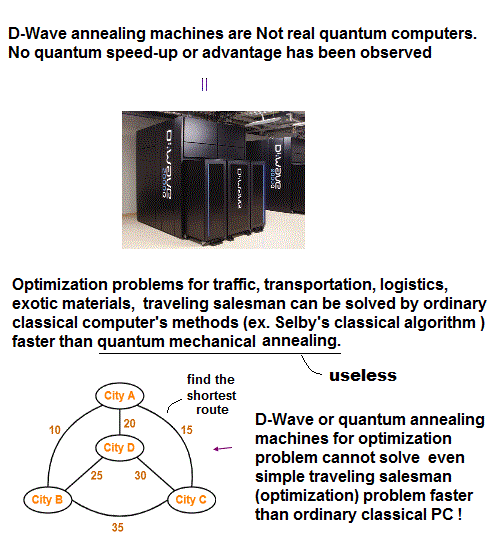
It is known that these quantum annealing machines are slower and more error-prone than ordinary classical computers using best classical calculation methods such as (classical) Selby's algorithm ( this 6th-paragraph, this 2nd-paragraph, this p.6-left-c ).
This 3rd-pagagraph says -- Classical beats D-Wave
"on every instance tested so far, Selby's (classical) annealing algorithm outperforms the D-wave machine,... they strategically included an unfair benchmark so that the news media could take the 100M speedup figure to fuel the hype machine"
This 15th, 19th paragraphs say -- Good classical beats quantum
"So besides (classical) simulated annealing, there are two more classical algorithms that are actors in this story. One of them is quantum Monte Carlo, which is actually a classical optimization method (= simulated annealing and Monte Carlo are bad slower classical computer's methods )"
"What the Google paper finds is that Selby's algorithm, which runs on a classical computer, totally outperforms the D-Wave machine on all the instances they tested"
↑ The faster classical computer's method called Selby outperformed D-Wave annealing machines.
This 2nd-last-paragraph says
"The VW research team also notes that their primary goal is.. not to prove supremacy over every existing classical clustering algorithm." ← Because quantum annealing is slower than the good classical computer's method.
↑ So all the overhyped ( fake ) quantum advantage claims in quantum annealing (= QA ) optimization problems is due to unfair comparison with slower bad classical methods such as simulated annealing (= SA ) and Monte Carlo (= MC ), as shown in this p.1-right-1st-paragraph, this p.5-left benchmark against simulated annealing, this p.47-X (= all of which did Not compare quantum annealing with faster classical methods such as Selby ).
Classical computer's best faster algorithm such as Selby can easily outperformed quantum annealing machines (= classical Selby gave more accurate results than the error-prone D-Wave (= DW ), this p.16-Table.2, p.15-lower ).
In some tasks, even against slow classical simulated annealing, quantum annealing could not show quantum advantage ( this p.1-abstract-lower ).
As a result, contrary to many (unfounded) hypes, (fake) quantum computers or quantum annealing are slower and showing No quantum advantage over ordinary classical computers ( this p.1-last ).
Actually, despite extremely longtime research and hypes, still Nobody and No companies use these overhyped D-Wave annealing machines for practical optimization problems (= Only a tiny number of companies use D-Wave only for fruitless researches or spreading hypes to get investment money or research funds ).
This p.2-4th-paragraph (9/9/2024) says -- No quantum advantaage
"the current implementations of quantum annealing in optimisation are limited in size and Not yet upscaled
to real-world situations" ← Quantum annealers or D-Wave are still useless.
This 8th-paragraph (5/23/2023) says
"but to date, No quantum computer has outperformed a classical supercomputer in practical tasks"
Also in one of optimization problems called travelling salesman problem finding shortest route, quantum annealing machines showed No advantage over classical computers ( this p.1-abstract, this abstract ).
This 5th-last-paragraph says
"In fact, it hasn't been proved yet that quantum annealing gives an advantage over classical optimization algorithms"
(Fig.2) Classical electric current difference induced by applied magnetic field generates D-Wave's flux qubit-0 and 1 states.
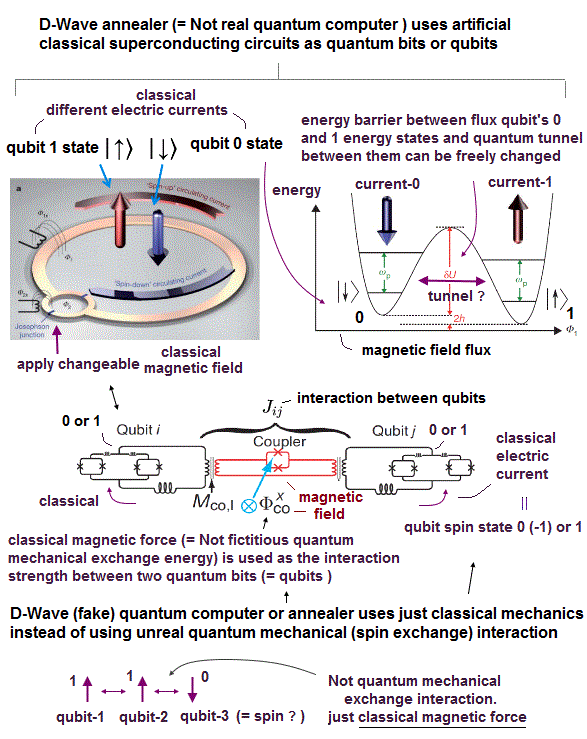
D-Wave annealing machines use the direction of classical electric current flowing through the superconducting circuit as their ( flux ) qubit state 0 or 1. No quantum mechanics is used.
Electron's current tends to be quantized due to the (classical) electron's ( an integer times ) de Broglie wavelength in D-Wave's superconducting flux qubit or circuit that can be manipulated by external magnetic field ( this p.6-7 ).
↑ By adjusting applied magnetic field (= flux ) in qubits (= classical superconducting circuits ) and couplers connecting qubits, D-Wave can optimize the final lowest-energy stable solution.
Quantum tunneling is a realistic classical phenomena (= electric current over only very short distance ) irrelevant to unrealistic quantum mechanical negative kinetic energy
(Fig.3) One of bad time-consuming classical methods called path integral Monte-Carlo (= PIMC ) ↓
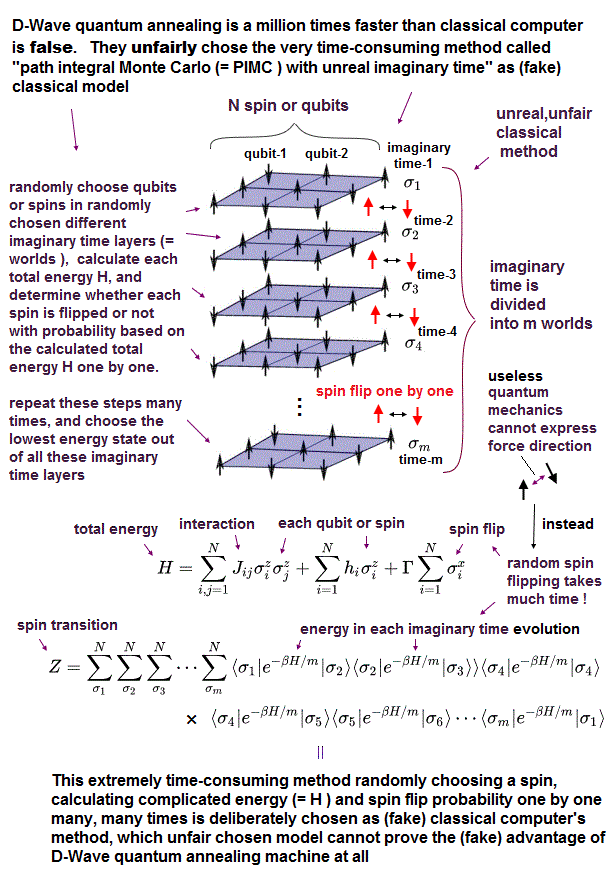
The (fake) quantum advantage of quantum annealing or D-Wave is caused by comparison with the artificially-chosen bad slow classical computer's methods such as simulated annealing and Monte-Carlo.
One of those bad classical methods is path integral Monte Calro (= PIMC ) method or quantum Monte Carlo (= QMC, this Fig.1B ) using the unreal imaginary time, which means PIMC can Not represent the realistic classical calculation method at all.
In this unrealistic very time-consuming classical method called path integral Monte Carlo, they first divide the process of annealing into many fictitious imaginary time periods (= σ1, σ2, σ2 .. σm, this p.2 ).
And then, they randomly chose an arbitrary qubit representing "spin direction" included in random imaginary times one by one, calculated the total energy (=H ) before and after the qubit (or spin ) flip ( 0 ↔ 1, this p.2 ), and decided whether this chosen qubit is flipped or not based on the calculated imaginary-time probabilities (= function of total energy, this p.30-40 ), until the system may reach the lowest energy state ( this p.20, this p.8, this p.9, this p.9 ).
↑ This impractical Monte Carlo classical method takes extremely much time, because it must randomly calculate each qubit's energy or flipping probability one by one without knowing the real forces by which all qubits naturally decide whether they flip or not simultaneously to lower the total energy.
Whether quantum or classical, all things and particles in the nature are gradually evolving into the lowest energy state by interacting and exerting real forces on each other simultaneously, which real classical process in the nature is completely different from these impractical extremely time-consuming artificial classical methods such as path integral Monte Carlo and simulated annealing unfairly chosen for comparison with the quantum annealing.
(Fig.4) Setting the right prime numbers (= 5 and 3 ) as the lowest-energy qubit state for factoring 15 = 5 × 3 using (impractical) quantum annealing.
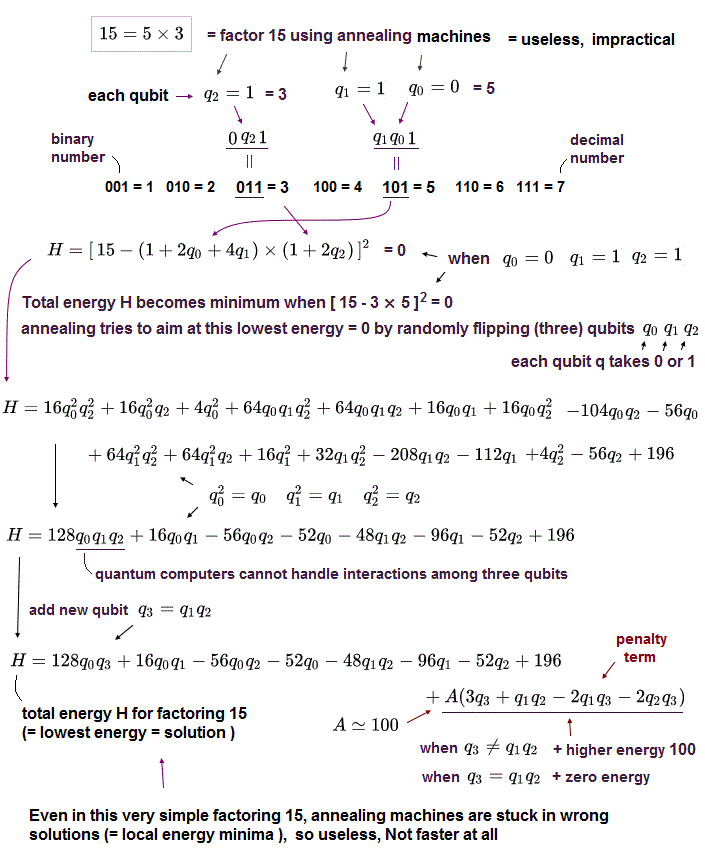
The only way for faster quantum computer's factoring is Shor's algorithm that is impractical (= only fake slower Shor's algorithm for 21 = 3 × 7 can be done ) forever.
Quantum annealing or adiabatic machines treating factoring as optimization problems (= minimization ) are useless, just publicity stunt.
Classical computers are far, far superior.
They encode solutions of factorization into the lowest energy state (= expressed as binary qubit states ) in D-Wave annealing machines.
The problem is quantum annealing or D-Wave often give wrong answers stuck in one of local energy minima instead of the lowest energy state (= right answers, this p.3 ).
Even in factoring the simplest 15 = 3 × 5, D-Wave annealing machines are known to often give wrong answers ( this p.55, this p.7-Figure 1, this p.34 ).
So when this quantum annealing or adiabatic methods try to factor large numbers, they have to know answers in advance to artificially reduce numbers of qubits.
This-p.1-right-lower says -- Fake quantum computer factoring
"the integer N = 291311 had been factorized using
the adiabatic (= equal to annealing, this-lower, this-4th-paragraph ) approach,..
Only 3 qubits were used in this case"
"we have experimentally factorized the integers 4088459 and 966887, using 2 and 4 qubits respectively."
↑ One qubit can take only 0 or 1 value, so just 4 qubits can express only up to 16 (= 24 ), which cannot express such large numbers as 291311, 966887.
↑ So they have to already know answers in advance to reduce numbers of qubits, which quantum adiabatic or annealing's factoring is completely useless.
In this-p.2-(1), they tried to factor 291311 = 523 × 557
↑ A binary number of 523 is "1000001011"
In this-p.2-(1)(2), they just used 3 unknown variables or qubits (= p5, p2, p1 ) to express this 523 = 1000001011 = 1000(p5)01(p2)(p1)1 (= other binary numbers except for these 3 variables must be known in advance ).
↑ So they had to already know the answer 291311 = 523 × 557 to reduce qubits' numbers, which is useless, cannot factor unknown values.

Feel free to link to this site.